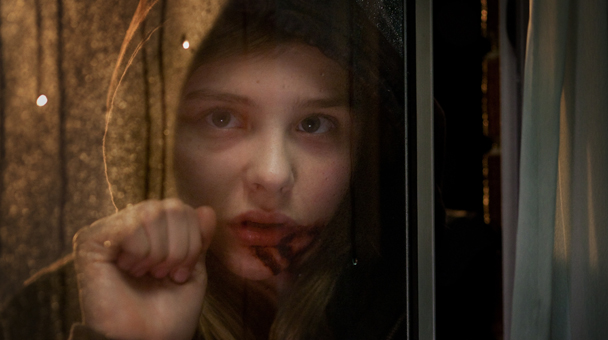Let Me In
If Matt Reeves really wanted a wider audience to see the original, he should have stepped in to give the film the proper distribution in America that it deserved.
Plot summary
A bullied young boy befriends a young female vampire who lives in secrecy with her guardian.

In 2008, Tomas Alfredson directed Let The Right One In from a screenplay adapted by John Ajvide Lindqvist, who also wrote the book of the same name. It was a Swedish success story. The film featured to wide critical acclaim on the film festival circuit and won numerous awards. Prior to its release, Cloverfield director Matt Reeves bought the rights to the film to widespread bemusement. He wanted to bring the story to a ‘wider audience’. Despite the universal praise, Let The Right One In opened in four cinemas in America, compared to Let Me In‘s opening of 2,021. So on that objective at least, the film is a success.
Let Me In follows the story of Owen (Smit-McPhee), a 12 year-old boy living in New Mexico. His home life is an unhappy one. His mother has turned to religion and alcohol following an apparent separation with his father and he spends most of his time alone outside sitting on a disused climbing frame. At school, he is bullied incessantly. He is soon joined on the climbing frame by Abby (Moretz) who walks barefoot in arctic conditions, enjoys puzzles, is probably about 12 (but she doesn’t know for sure) and, erm, drinks blood to stay alive.
Her lust for blood is catered to by a man who looks like he should be her father. He is the Renwig to her Nosferatu. However, his efforts are getting sloppy and, as the murders pile up, he is getting closer and closer to getting caught. Meanwhile, a gentle young romance is blossoming between Abby and Owen whom, with childlike innocence, seems to accept that she is a vampire.
This is not a bad film by any means. In fact, it shares many of the facets that made the original so good. The film is well cast; Moretz and Smit-McPhee (possibly the top two child actors in Hollywood right now) are excellent as Owen and Abby. There is some innovative cinematography but, despite all the good in the film, I sat there thinking “…what is the point of this?”
The atmosphere of the isolated Swedish village, with the gothic, ominous aura and the beautifully sweeping shots of snow that was so visually arresting in the original is something that just couldn’t be replicated by a big-budget Hollywood movie. The subtle nature of the first film was completely thrown away; the real relationship between Abby and ‘The Father’ (i.e. Renwig) may as well have been written down on a piece of paper and individually thrust into the audience’s faces, rather than allowing everyone to play on their own assumptions.
It was the ending that annoyed me the most – not the final moments of the film, but the beginning of the credits. More specifically, it was seven words – “adapted for the screen by Matt Reeves”- probably the same amount of words he added to the script to be allowed to say that.
In many ways, it reminded me of Gus Van Sant’s remake of Psycho, in which he added colour (something Hitchcock decided against even though it was at his disposal for the original), a Vince Vaughn wank scene and not much else. The difference being that the Psycho remake was shot-by-shot, Reeves at least had the intelligence to mix some of the scenes around.
The only negative I could say about the Swedish version, and this is if I am being very, very picky, was that I thought that the use of fire was poor CGI. At the time, I put this down to the film’s budget. This time, with a much bigger budget, and the experience of making a film like Cloverfield (which included CGI that was so ambitious and so innovative), they still couldn’t make the fire look real. This was one of many rotten features of this exhumed corpse.
Let Me In had a lot of positive aspects but, the truth is, I’ve seen a better version of this film already
What was the point of making it again? Seriously, what is the actual point? For people too lazy to read the subtitles? For the money? For the respect of turning something ‘truly excellent’ into something ‘quite good’? If Matt Reeves really wanted a wider audience to see the film, he should have stepped in to give the film the proper distribution in America that it deserved.











COMMENTS